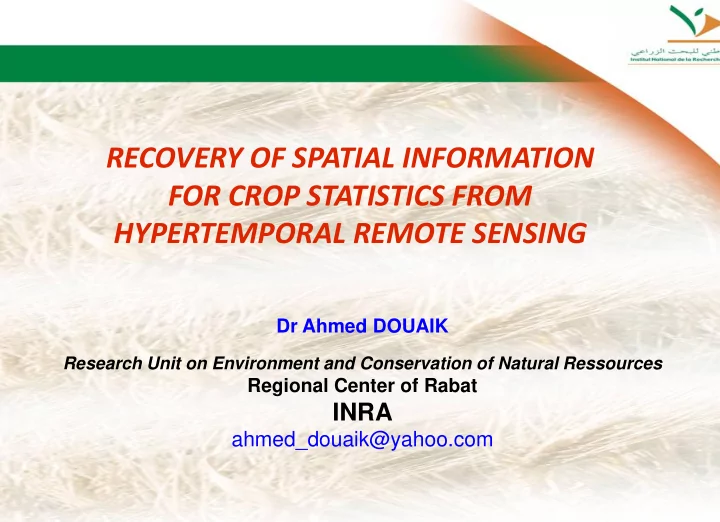

RECOVERY OF SPATIAL INFORMATION FOR CROP STATISTICS FROM HYPERTEMPORAL REMOTE SENSING Dr Ahmed DOUAIK Research Unit on Environment and Conservation of Natural Ressources Regional Center of Rabat INRA ahmed_douaik@yahoo.com
Outline Introduction Material and Methods Results and Discussion Conclusions 2
Introduction Conventional methods of land use and land cover mapping and monitoring are laborious and expensive Time series of NDVI used to discriminate between vegetation and other land uses, and between different vegetation types Crop statistics not informing about the spatial extent within administrative units Objective adding spatial information to crop statistics using hypertemporal RS data (temporal NDVI profiles).
Material and Methods Study area 6 Mandals or sub-districts Total area: 1300 km 2 Cropland: 90000 Ha West Nizamabad
Data • NDVI: 147 Spot Vegetation composite images * spatial resolution: 1 km 2 * decadal * period: April 1998 - April 2002 • Land cover map at 1/50000 scale * images acquired in 1994/1995 * IRS-C (Liss-III sensor, spatial resolution: 23 m) * original 18 legend entries reduced to 7 • Crop statistics: cropped areas by administrative units
Methods NDVI = (IR- R) / (IR + R) DN = (NDVI + 0.1) / 0.004 Unsupervised classification: ISODATA algorithm (2 to 30 clusters) Cropland areas masked using land cover map Stepwise multiple linear regression: n CA c * NDVIcluste r i i i 1 Generating maps showing cropped fractions by map units Softwares: ArcGIS, ERDAS Imagine and SPSS
Results and Discussion Number of clusters Average Divergence Minimum Divergence 14000 200 12000 180 10000 160 Divergence Divergence 8000 140 6000 120 4000 100 2000 80 0 2 4 6 8 10 12 14 16 18 20 22 24 26 28 30 2 4 6 8 10 12 14 16 18 20 22 24 26 28 30 Number of clusters Number of clusters
Average spectral signatures Mean Signature Profile 250 200 Series1 Series2 Series3 Series4 Series5 Series6 150 Series7 Mean Signature Series8 Series9 Series10 Series11 Series12 100 Series13 Series14 Series15 Series16 Series17 Series18 50 0 0 20 40 60 80 100 120 140 160 Decade Average signature (8 clusters) 250 200 Class 1 150 Class 2 Average signature Class 030405060710 Class 08091114 Class 1213 Class 15 Class 16 100 Class 1718 50 0 0 10 20 30 40 50 60 70 80 90 100 110 120 130 140 150 Decade
NDVI-unit map
Stepwise multiple linear regression NDVI units Kharif Adjusted R 2 3 4 6 7 Area (Ha) Cotton 87.5 15.6 6860 Maize 81.3 4.1 482 Pulses 96.9 48.0 64.1 29121 Rice 95.0 50.3 75.3 22774 Sugarcane 89.9 26.0 2395 Rabi Groundnut 80.3 53.2 5942 Pulses 80.9 5.5 2824 Rice 99.8 1.8 69.1 25.0 11481 Sorghum 86.1 32.5 15454 Sugarcane 85.9 21.6 1960 Total Area (Ha) both seasons 42409 13488 8920 18216
Estimated maps for rice
Conclusion Benefit of integrating hypertemporal remote sensing data with crop statistics to: * delineate NDVI profile clusters with their land cover map units * link these statistics to geographical locations These map units used for future monitoring of natural resources (crop growth, forecasting crop production, risk awareness like drought, etc.)
Tha Thank nk Yo You For u For Yo Your ur Kin Kind d Att Atten ention tion
Recommend
More recommend